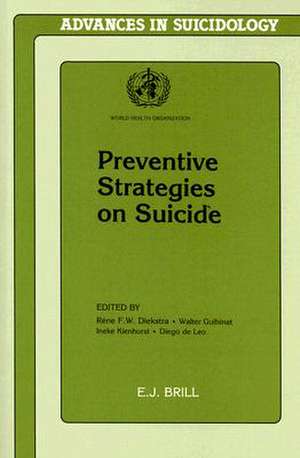Preventive Strategies on Suicide: Advances in Suicidology, cartea 2
Editat de Diekstra, Gulbinat, Kienhorst, Leoen Limba Engleză Paperback – 31 oct 1995
It follows that suicide is an extremely important public health problem. It is, however, a problem that is painfully neglected. Throughout the world, resources devoted to the prevention of suicide are only a tiny fraction of those devoted to the prevention of comparable problems, such as road traffic accidents, or to problems oflesser magnitude, at least in the industrialized countries, such as HIV-infection and Aids.
This volume, produced under the supervision and auspices of the World Health Organization, brings together for the first time information on epidemiological, clinical and preventive
Preț: 866.52 lei
Preț vechi: 1056.74 lei
-18% Nou
Puncte Express: 1300
Preț estimativ în valută:
165.83€ • 171.31$ • 138.01£
165.83€ • 171.31$ • 138.01£
Carte indisponibilă temporar
Doresc să fiu notificat când acest titlu va fi disponibil:
Se trimite...
Preluare comenzi: 021 569.72.76
Specificații
ISBN-13: 9789004103399
ISBN-10: 9004103392
Pagini: 369
Dimensiuni: 161 x 240 x 24 mm
Greutate: 0.69 kg
Editura: Brill
Colecția Brill
Seria Advances in Suicidology
ISBN-10: 9004103392
Pagini: 369
Dimensiuni: 161 x 240 x 24 mm
Greutate: 0.69 kg
Editura: Brill
Colecția Brill
Seria Advances in Suicidology
Public țintă
The volume is of relevance to health care professionals and paraprofessionals, lay volunteers and their organizations, health policy makers and all those involved or interested in suicide and its prevention.Descriere
Recent estimates by The World Health Organisation and The World Bank indicate that throughout the world each and every year more than 800,000 persons die as a consequence of suicide. This means that the death toll of suicide equals and in many countries even exceeds that of road traffic accidents. In addition to the number of suicidal deaths, at least ten times as many persons make non-fatal attempts to take their lives or harm themselves, often seriously enough to require medical attention and not infrequently resulting in irreversible disability. But still these figures inadequately describe the magnitude of human loss and suffering caused by suicide. If one assumes that for every suicidal death there are at least five persons whose lives are profoundly and often for many years affected by the event -emotionally, socially and economically-, by the event, then each year millions of survivor-victims are added to the tens of millions already 'out there'. Hence, suicide is an ever-recurring catastrophe of the first degree. It is not a phenomenon that first and foremost forms a dubious privilege of the so-called highly developed countries. Suicide also occurs in the developing countries and there is more than suggestive evidence that in several of these countries the suicide rate equals or even surpasses the highest national rates shown by offical statistics.
It follows that suicide is an extremely important public health problem. It is, however, a problem that is painfully neglected. Throughout the world, resources devoted to the prevention of suicide are only a tiny fraction of those devoted to the prevention of comparable problems, such as road traffic accidents, or to problems of lesser magnitude, at least in the industrialized countries, such as HIV-infection and Aids.
This volume, produced under the supervision and auspices of the World Health Organization, brings together for the first time information on epidemiological, clinical and preventive intervention aspects regarding suicide that have global significance and applicability. After a detailed description of the epidemiology of suicide and suicidal behaviour on an international scale, a large part of the book is devoted to the 'how-to's' of developing and organizing suicide prevention programs and services in different national and cultural settings, both at clinical and community level. In addition, a wealth of practical information for health care workers and volunteers is provided on how to evaluate and deal with acute suicide risk. Examples of successful preventive intervention programs and projects, from the developed as well as the developing world, are provided. Legal and ethical problems involved in suicide prevention are also discussed.
Finally, both cultural and biological aspects of suicidal behaviour, as well as their clinical-practice relevance, are examined.
It follows that suicide is an extremely important public health problem. It is, however, a problem that is painfully neglected. Throughout the world, resources devoted to the prevention of suicide are only a tiny fraction of those devoted to the prevention of comparable problems, such as road traffic accidents, or to problems of lesser magnitude, at least in the industrialized countries, such as HIV-infection and Aids.
This volume, produced under the supervision and auspices of the World Health Organization, brings together for the first time information on epidemiological, clinical and preventive intervention aspects regarding suicide that have global significance and applicability. After a detailed description of the epidemiology of suicide and suicidal behaviour on an international scale, a large part of the book is devoted to the 'how-to's' of developing and organizing suicide prevention programs and services in different national and cultural settings, both at clinical and community level. In addition, a wealth of practical information for health care workers and volunteers is provided on how to evaluate and deal with acute suicide risk. Examples of successful preventive intervention programs and projects, from the developed as well as the developing world, are provided. Legal and ethical problems involved in suicide prevention are also discussed.
Finally, both cultural and biological aspects of suicidal behaviour, as well as their clinical-practice relevance, are examined.

